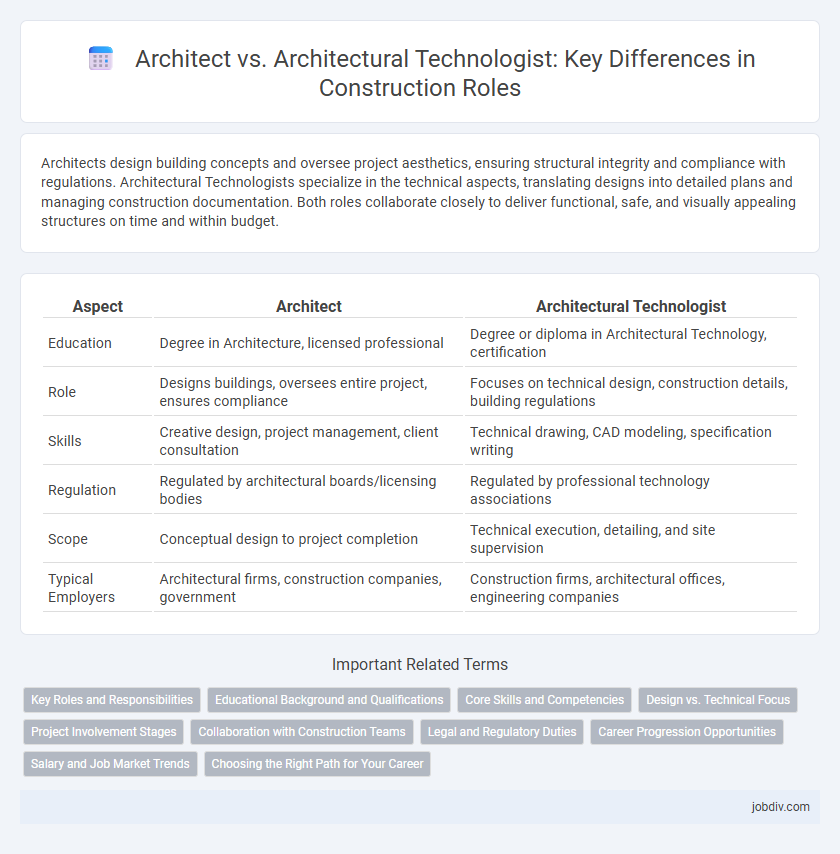Architects design building concepts and oversee project aesthetics, ensuring structural integrity and compliance with regulations. Architectural Technologists specialize in the technical aspects, translating designs into detailed plans and managing construction documentation. Both roles collaborate closely to deliver functional, safe, and visually appealing structures on time and within budget.
Table of Comparison
| Aspect | Architect | Architectural Technologist |
|---|---|---|
| Education | Degree in Architecture, licensed professional | Degree or diploma in Architectural Technology, certification |
| Role | Designs buildings, oversees entire project, ensures compliance | Focuses on technical design, construction details, building regulations |
| Skills | Creative design, project management, client consultation | Technical drawing, CAD modeling, specification writing |
| Regulation | Regulated by architectural boards/licensing bodies | Regulated by professional technology associations |
| Scope | Conceptual design to project completion | Technical execution, detailing, and site supervision |
| Typical Employers | Architectural firms, construction companies, government | Construction firms, architectural offices, engineering companies |
Key Roles and Responsibilities
Architects lead the design process, creating conceptual plans and ensuring aesthetic and functional building design while complying with regulations and client needs. Architectural technologists focus on the technical implementation of architectural designs, producing detailed drawings, specifications, and overseeing the construction documentation process. Both professionals collaborate closely to deliver structures that are functional, safe, and visually appealing, with architects emphasizing creative vision and technologists ensuring practical execution.
Educational Background and Qualifications
Architects typically hold a professional degree in architecture, such as a Bachelor or Master of Architecture, and must complete accredited programs followed by internships and licensure exams to practice officially. Architectural Technologists generally earn a diploma or degree in architectural technology, emphasizing technical and practical aspects of building design, often without the requirement of licensure. Both roles require continuous professional development but differ significantly in educational pathways, with architects focusing on design theory and creative processes, while technologists concentrate on construction methods and material specifications.
Core Skills and Competencies
Architects possess advanced skills in design conceptualization, project visualization, and regulatory compliance, enabling them to create innovative and functional building designs. Architectural Technologists specialize in technical detailing, construction methods, and building sciences, ensuring accurate specification and integration of materials and systems. Both professionals require proficiency in CAD software, building codes, and project management to successfully deliver complex construction projects.
Design vs. Technical Focus
Architects emphasize creative design, conceptual planning, and aesthetic aspects of building projects, ensuring functionality and visual impact meet client expectations. Architectural Technologists concentrate on the technical implementation, structural integrity, building regulations, and material specifications to translate designs into feasible construction solutions. Collaboration between architects and architectural technologists optimizes both innovative design and precise technical execution in construction projects.
Project Involvement Stages
Architects lead the conceptual design and planning stages, developing creative, functional, and regulatory-compliant blueprints for construction projects. Architectural technologists focus on the technical detailing, construction documentation, and implementation phases, ensuring design feasibility and adherence to building codes. Both roles collaborate during project handover and site inspections to guarantee structural integrity and project fidelity.
Collaboration with Construction Teams
Architects design and conceptualize building projects, setting the vision and ensuring compliance with regulations, while architectural technologists focus on the technical implementation and detailed construction documentation. Effective collaboration between these professionals and construction teams streamlines project delivery by aligning creative design intent with practical building methods and materials. This synergy reduces errors, accelerates timelines, and enhances the overall quality and feasibility of construction projects.
Legal and Regulatory Duties
Architects hold statutory responsibilities for signing off building designs and ensuring compliance with local building codes and zoning laws, often requiring specific licensure mandated by regulatory bodies. Architectural technologists specialize in the technical aspects of design implementation, working under the architect's supervision but typically lack the legal authority to approve or submit plans independently. Both roles demand adherence to health and safety regulations, though architects bear the ultimate legal accountability for the construction project's regulatory compliance.
Career Progression Opportunities
Architects often have broader career progression opportunities, including roles in project management, design leadership, and firm partnership due to their comprehensive training in design, planning, and regulations. Architectural Technologists typically advance through technical specialist roles, becoming experts in building technology, CAD management, or construction detailing, with opportunities in project coordination and technical consultancy. Both career paths offer progression but differ in focus, with architects leaning towards creative and strategic roles, while technologists emphasize technical precision and building execution.
Salary and Job Market Trends
Architects typically earn higher salaries, with median annual wages around $82,000, compared to architectural technologists whose salaries average approximately $55,000 to $65,000, depending on experience and region. The job market for architects remains competitive due to licensing requirements and a focus on design innovation, while architectural technologists are in growing demand for their technical expertise in building systems and construction technology. Emerging trends show increased integration of digital tools and sustainable design practices, benefiting both professions but particularly boosting opportunities for architectural technologists in project implementation roles.
Choosing the Right Path for Your Career
Architects lead building design with creative vision and regulatory expertise, often requiring a professional license and a professional degree such as a Master of Architecture. Architectural Technologists specialize in the technical aspects of construction, including drafting detailed plans and ensuring compliance with building codes, typically holding a diploma or degree in architectural technology. Choosing the right path depends on whether you prefer conceptual design and project leadership or hands-on technical problem-solving within the construction process.
Architect vs Architectural Technologist Infographic

 jobdiv.com
jobdiv.com